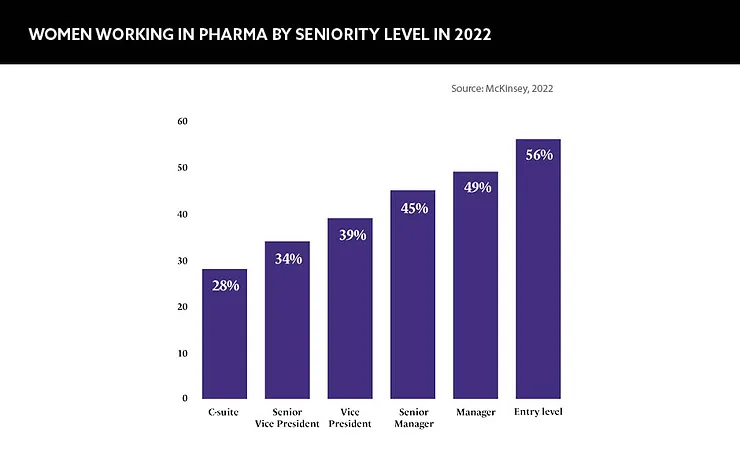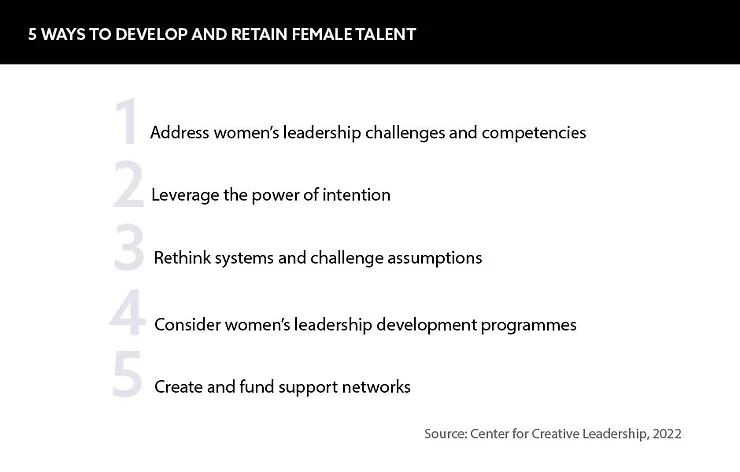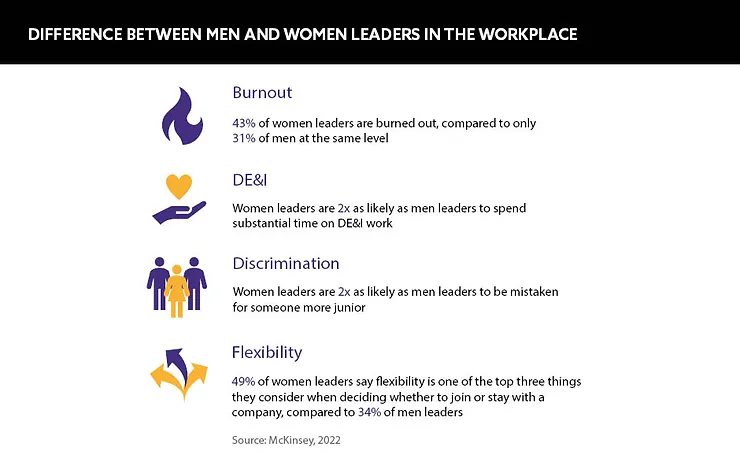There are far fewer women than men in the upper echelons of the pharmaceutical industry, and it is time to address the imbalance. The industry needs to recruit and retain more female leaders for the benefit of women, organisations and patients. But how?
Words by Isabel O’Brien
Can women have it all? This was the controversial question posed by the BBC in a now-deleted headline announcing the resignation of New Zealand Prime Minister Jacinda Ardern in January 2023. The politician had just announced her departure after six years in office, saying she had “nothing left in the tank” to continue in the role.
Critics have denounced the ‘sexist’ and ‘misogynistic’ question, and one Twitter user pointed out that the BBC headline should have read ‘Jacinda Ardern resigns: a world leader shows courage by breaking the taboo of discussing emotional and mental well-being’. The headline was clearly misjudged, but, beyond the scandal itself, the incident points to a wider issue. If people are still asking whether women can have it all, then, clearly, women are still at a disadvantage to men in the professional world.
“Equity in the workplace is about creating an inclusive environment where everyone has an opportunity to reach their full potential,” explains Wendy White, Interim CEO, Healthcare Businesswomen’s Association. “Focusing solely on equality of opportunity assumes that everyone has the same starting point and equal access to opportunities, which is not always the case.”
So, what barriers do women face in becoming senior pharmaceutical executives, and how can the industry increase the number of women reaching and remaining in leadership?
The broader picture
Of all the 195 countries in the world, only 15% are led by women. This is according to data published by the UN in September 2022, which also predicted that it will take 130 years to achieve gender equality in the highest positions of power.
While this statistic suggests that no one alive today will live to see improved gender diversity among world leaders, hopefully fairer representation at the highest levels of the pharma industry is something that can be achieved in the nearer future.
Companies shouldn’t try to fix this issue by ‘fixing women’
“We need to demonstrate and cherish diversity,” says Zsuzsanna Devecseri, Vice President, Head of Global Oncology Medical Affairs, Sanofi. ‘“Human nature prefers safety and surrounds itself with people of similar kind. This can mean missing out the beauty and benefits of being different.” To illustrate her point, she refers to the Latin proverb ‘similis simili gaudet’, or ‘like rejoices in like’. To improve diversity within organisations, businesses must be aware of the inherent biases that perpetuate gender imbalances in the first place.
“Companies shouldn’t try to solve this problem by ‘fixing women’,” corroborates Cristina Ortega Durán, Chief Digital Health Officer, R&D, AstraZeneca. This suggests that “women are the problem”, she points out, rather than the systems in which they work.
Recruiting talent
According to a report by McKinsey, more than half of new entrants to the pharma industry in 2022 were women. This is hugely positive when compared to other industries such as oil and gas, but it loses some of its lustre when it is learned that almost three-quarters of pharma C-suite members are men.
A solution offered by Nana Scotto, Vice President and Global Head Medical Affairs Oncology, AstraZeneca, is around goal setting and culpability. “It is really about setting clear diversity aspirations, backed by accountability at the company level,” she says. “This will serve as a best practice for more diverse representation in leadership roles.”
Aspirations could involve aiming for a percentage of women in the organisation. AstraZeneca, for example, has publicly committed to achieving 50% gender representation, including at senior levels, by 2025.
Another idea is identifying women for leadership positions at the beginning of their careers and enrolling them in fast-track or mentorship schemes. “We need to start early and prepare women for leadership roles,” says Devecseri, warning that “it shouldn’t be a game of numbers, but matching the right person with the right job.”
She says while early recognition is valuable, the right individual must not be pushed at the wrong pace. Tailored approaches are the best way to help future talent to climb the ladder.
While organisations should prioritise taking action themselves to improve representation, creating forums for female employees to speak out and identify the barriers they are experiencing is another avenue to create change. “The more women who are able to acknowledge that their thoughts and feelings are heard, the more likely they’ll be to want to grow into and stay in leadership roles,” Scotto points out.
Her thoughts are echoed by Ortega Durán, who urges all women to take up the mission. “Don’t wait for others to guess what you want – you have to tell them or offer to lead and be part of the solution,” she says.

Retaining leaders
Three top female political leaders have left their positions in the last two years alone. Jacinda Ardern’s resignation came between Angela Merkel’s departure as Chancellor of Germany in 2021 and Nicola Sturgeon’s decision to step down as First Minister of Scotland, announced on 15 February 2023.
All three women chose to step down, and they should be applauded for their achievements and for knowing when it was time to reprioritise. However, the resignations have led some commentators to ask whether female leaders are undersupported and under too much pressure in the highest positions of power. If so, how can this be avoided in the pharma?
“It still happens regularly that I am the only or one of the few female leaders around the table,” says Devecseri. “It makes it hard to make our voice heard just based on the airtime we can get.” Retaining female leaders isn’t just a numbers game, but it certainly helps to have more women at the top, supporting each other and nurturing new talent in turn.
“We need more women. We need more women who don’t want to be men or act and lead as men do,” Devecseri continues. Not only is this positive for the retention of female leaders, but it can also serve the wider organisation.
According to the Potential Project, a global research and leadership development company, women are better at demonstrating a leadership style called ‘compassionate wisdom’. This specific approach can lead to more engaged, happy and productive teams, and it has the potential to reduce the human capital costs that businesses fear today.
“We need more women who can think beyond the numbers and bring the human perspective to our strategies,” says Devecseri. “In pharma, we have always looked at our strategy through hard facts and numbers, but that is only part of the picture,” she adds.
We need more women. We need more women who don’t want to be men or act and lead as men do
However, the figures could also benefit from a boost. A study by investment firm First Sentier Investors found that retaining female executives can lead to a cumulative return on equity for companies that is nearly 30% higher than their less diverse counterparts. The benefits are clear, but what else can companies do to support women to stay in leadership?
“An organisation that is truly committed to retaining female talent must not only ensure that they are able to hear from their female representatives, but they must also be willing to invest in the organisational changes that are important to them,” notes Scotto. She references several changes that could add value, including cultural evolutions, supportive tools and protecting flexible working patterns.
Worryingly, the latter benefit could be widely under threat as research by Microsoft has revealed that up to 50% of employers are considering a return to full-time, face-to-face working in the next year. This decision shouldn’t be taken lightly as it could reduce the number of senior female leaders with families who are able to balance their professional and personal lives.
This is evidenced in a study by McKinsey, which found that 49% of women leaders say flexibility is one of the top three things they consider when deciding whether to join or stay with a company.

Representation matters
Beyond the obvious benefits to women and their organisations, fair representation at the top of pharma is important for another reason: the impact on the people being served. When women are not represented at the highest levels of power, women’s and other issues can get lost in the fray.
It is telling, for example, that the UK government only announced its first dedicated women’s health strategy in 2022. At the time, Janet Lindsay, CEO, Wellbeing of Women, noted that “a key focus on prioritising women’s health is long overdue”. She said that women’s health issues had been “neglected and underfunded for many generations”, leading to “shocking inequalities persisting across society”.
Equity in the workplace is about creating an inclusive environment where everyone has an opportunity to reach their full potential
The pharma industry needs to be aware of this cycle and come up with solutions to avoid perpetuating it. “This is an industry that affects everyone in the world,” White reminds us. “There are many challenges and opportunities ahead of us that require a collective and innovative approach.” Historical issues include the under-representation of women in clinical trials and the inadequate mechanisms for diagnosing and treating women’s health problems, amongst others.
With global healthcare challenges only set to increase, it will be vital to have a workforce that reflects the population at large to ensure fair attention to all health issues.
This is a view shared by Scotto, who has a clear vision for the future. “Our industry will benefit when all genders have equal opportunities to help solve the most pressing challenges in healthcare,” she says. This isn’t a mission to apportion blame for past failures, but a desire to make things better and fairer for the benefit of future research and patients. As Scotto notes: “It’s not a nice-to-have, it’s a must-have.”
It is clear that companies could be doing more to recruit and retain female leaders. If they are prepared to challenge biases and remove barriers, improved representation and outcomes will be the reward. “By creating an environment where all women can thrive and succeed, organisations can ensure that they are not just hiring token female leaders, but creating sustainable change,” concludes White.
Greater equity of opportunity could be the answer, but will pharma choose it to take it?
Case study
Cristina Ortega Durán, Chief Digital Health Officer, R&D, AstraZeneca, shares her thoughts on the problem with gender bias
While there has been great progress, a perception bias persists in society. A few years ago, my son and I were playing Lego. I picked up a female character and introduced her as ‘the boss’ in the game. My son looked at me and – in all his innocence at five years of age – said, “no, Mum! Girls can’t be the boss.” And upon asking why not, the answer was: “Because the boy is always the boss in the Lego movies!” Despite having reached a leadership role myself by this time, he had unconsciously absorbed the pervasive gender bias that surrounds us to this day in popular culture and our social norms. It’s these cultural and social norms that we need to overcome.







